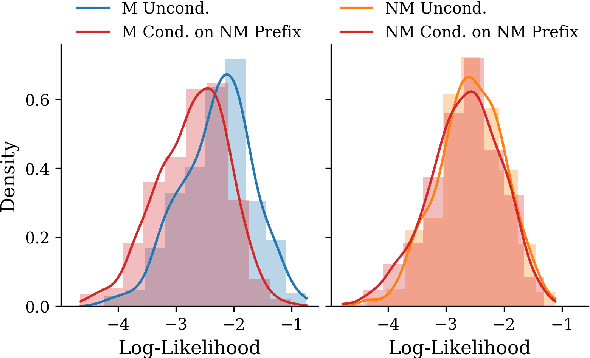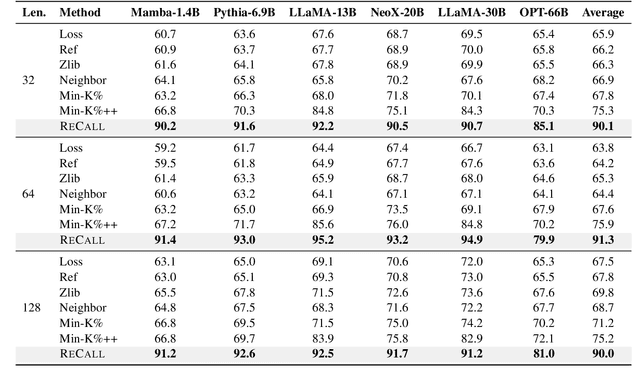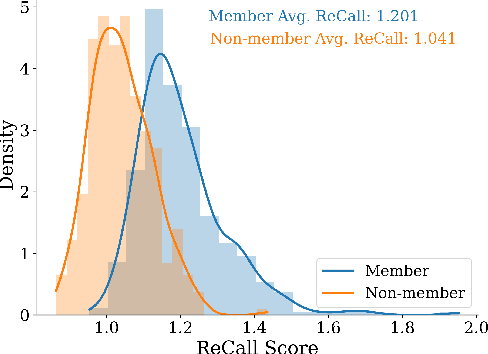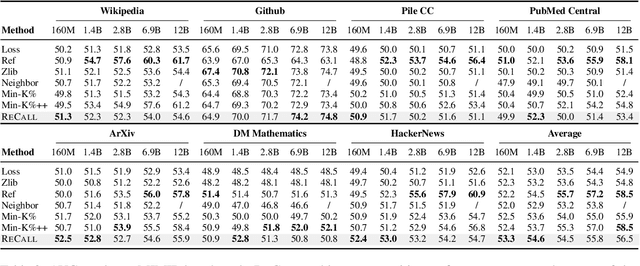Jian Pei
Duke University
On Membership Inference Attacks in Knowledge Distillation
May 17, 2025Abstract:Nowadays, Large Language Models (LLMs) are trained on huge datasets, some including sensitive information. This poses a serious privacy concern because privacy attacks such as Membership Inference Attacks (MIAs) may detect this sensitive information. While knowledge distillation compresses LLMs into efficient, smaller student models, its impact on privacy remains underexplored. In this paper, we investigate how knowledge distillation affects model robustness against MIA. We focus on two questions. First, how is private data protected in teacher and student models? Second, how can we strengthen privacy preservation against MIAs in knowledge distillation? Through comprehensive experiments, we show that while teacher and student models achieve similar overall MIA accuracy, teacher models better protect member data, the primary target of MIA, whereas student models better protect non-member data. To address this vulnerability in student models, we propose 5 privacy-preserving distillation methods and demonstrate that they successfully reduce student models' vulnerability to MIA, with ensembling further stabilizing the robustness, offering a reliable approach for distilling more secure and efficient student models. Our implementation source code is available at https://github.com/richardcui18/MIA_in_KD.
Advances and Challenges in Foundation Agents: From Brain-Inspired Intelligence to Evolutionary, Collaborative, and Safe Systems
Mar 31, 2025Abstract:The advent of large language models (LLMs) has catalyzed a transformative shift in artificial intelligence, paving the way for advanced intelligent agents capable of sophisticated reasoning, robust perception, and versatile action across diverse domains. As these agents increasingly drive AI research and practical applications, their design, evaluation, and continuous improvement present intricate, multifaceted challenges. This survey provides a comprehensive overview, framing intelligent agents within a modular, brain-inspired architecture that integrates principles from cognitive science, neuroscience, and computational research. We structure our exploration into four interconnected parts. First, we delve into the modular foundation of intelligent agents, systematically mapping their cognitive, perceptual, and operational modules onto analogous human brain functionalities, and elucidating core components such as memory, world modeling, reward processing, and emotion-like systems. Second, we discuss self-enhancement and adaptive evolution mechanisms, exploring how agents autonomously refine their capabilities, adapt to dynamic environments, and achieve continual learning through automated optimization paradigms, including emerging AutoML and LLM-driven optimization strategies. Third, we examine collaborative and evolutionary multi-agent systems, investigating the collective intelligence emerging from agent interactions, cooperation, and societal structures, highlighting parallels to human social dynamics. Finally, we address the critical imperative of building safe, secure, and beneficial AI systems, emphasizing intrinsic and extrinsic security threats, ethical alignment, robustness, and practical mitigation strategies necessary for trustworthy real-world deployment.
Representation learning of dynamic networks
Dec 15, 2024Abstract:This study presents a novel representation learning model tailored for dynamic networks, which describes the continuously evolving relationships among individuals within a population. The problem is encapsulated in the dimension reduction topic of functional data analysis. With dynamic networks represented as matrix-valued functions, our objective is to map this functional data into a set of vector-valued functions in a lower-dimensional learning space. This space, defined as a metric functional space, allows for the calculation of norms and inner products. By constructing this learning space, we address (i) attribute learning, (ii) community detection, and (iii) link prediction and recovery of individual nodes in the dynamic network. Our model also accommodates asymmetric low-dimensional representations, enabling the separate study of nodes' regulatory and receiving roles. Crucially, the learning method accounts for the time-dependency of networks, ensuring that representations are continuous over time. The functional learning space we define naturally spans the time frame of the dynamic networks, facilitating both the inference of network links at specific time points and the reconstruction of the entire network structure without direct observation. We validated our approach through simulation studies and real-world applications. In simulations, we compared our methods link prediction performance to existing approaches under various data corruption scenarios. For real-world applications, we examined a dynamic social network replicated across six ant populations, demonstrating that our low-dimensional learning space effectively captures interactions, roles of individual ants, and the social evolution of the network. Our findings align with existing knowledge of ant colony behavior.
A Survey on Data Markets
Nov 09, 2024



Abstract:Data is the new oil of the 21st century. The growing trend of trading data for greater welfare has led to the emergence of data markets. A data market is any mechanism whereby the exchange of data products including datasets and data derivatives takes place as a result of data buyers and data sellers being in contact with one another, either directly or through mediating agents. It serves as a coordinating mechanism by which several functions, including the pricing and the distribution of data as the most important ones, interact to make the value of data fully exploited and enhanced. In this article, we present a comprehensive survey of this important and emerging direction from the aspects of data search, data productization, data transaction, data pricing, revenue allocation as well as privacy, security, and trust issues. We also investigate the government policies and industry status of data markets across different countries and different domains. Finally, we identify the unresolved challenges and discuss possible future directions for the development of data markets.
Ask Questions with Double Hints: Visual Question Generation with Answer-awareness and Region-reference
Jul 06, 2024



Abstract:The visual question generation (VQG) task aims to generate human-like questions from an image and potentially other side information (e.g. answer type). Previous works on VQG fall in two aspects: i) They suffer from one image to many questions mapping problem, which leads to the failure of generating referential and meaningful questions from an image. ii) They fail to model complex implicit relations among the visual objects in an image and also overlook potential interactions between the side information and image. To address these limitations, we first propose a novel learning paradigm to generate visual questions with answer-awareness and region-reference. Concretely, we aim to ask the right visual questions with Double Hints - textual answers and visual regions of interests, which could effectively mitigate the existing one-to-many mapping issue. Particularly, we develop a simple methodology to self-learn the visual hints without introducing any additional human annotations. Furthermore, to capture these sophisticated relationships, we propose a new double-hints guided Graph-to-Sequence learning framework, which first models them as a dynamic graph and learns the implicit topology end-to-end, and then utilizes a graph-to-sequence model to generate the questions with double hints. Experimental results demonstrate the priority of our proposed method.
EHRmonize: A Framework for Medical Concept Abstraction from Electronic Health Records using Large Language Models
Jun 28, 2024



Abstract:Electronic health records (EHRs) contain vast amounts of complex data, but harmonizing and processing this information remains a challenging and costly task requiring significant clinical expertise. While large language models (LLMs) have shown promise in various healthcare applications, their potential for abstracting medical concepts from EHRs remains largely unexplored. We introduce EHRmonize, a framework leveraging LLMs to abstract medical concepts from EHR data. Our study uses medication data from two real-world EHR databases to evaluate five LLMs on two free-text extraction and six binary classification tasks across various prompting strategies. GPT-4o's with 10-shot prompting achieved the highest performance in all tasks, accompanied by Claude-3.5-Sonnet in a subset of tasks. GPT-4o achieved an accuracy of 97% in identifying generic route names, 82% for generic drug names, and 100% in performing binary classification of antibiotics. While EHRmonize significantly enhances efficiency, reducing annotation time by an estimated 60%, we emphasize that clinician oversight remains essential. Our framework, available as a Python package, offers a promising tool to assist clinicians in EHR data abstraction, potentially accelerating healthcare research and improving data harmonization processes.
ReCaLL: Membership Inference via Relative Conditional Log-Likelihoods
Jun 23, 2024



Abstract:The rapid scaling of large language models (LLMs) has raised concerns about the transparency and fair use of the pretraining data used for training them. Detecting such content is challenging due to the scale of the data and limited exposure of each instance during training. We propose ReCaLL (Relative Conditional Log-Likelihood), a novel membership inference attack (MIA) to detect LLMs' pretraining data by leveraging their conditional language modeling capabilities. ReCaLL examines the relative change in conditional log-likelihoods when prefixing target data points with non-member context. Our empirical findings show that conditioning member data on non-member prefixes induces a larger decrease in log-likelihood compared to non-member data. We conduct comprehensive experiments and show that ReCaLL achieves state-of-the-art performance on the WikiMIA dataset, even with random and synthetic prefixes, and can be further improved using an ensemble approach. Moreover, we conduct an in-depth analysis of LLMs' behavior with different membership contexts, providing insights into how LLMs leverage membership information for effective inference at both the sequence and token level.
A Comprehensive Survey on Data Augmentation
May 17, 2024



Abstract:Data augmentation is a series of techniques that generate high-quality artificial data by manipulating existing data samples. By leveraging data augmentation techniques, AI models can achieve significantly improved applicability in tasks involving scarce or imbalanced datasets, thereby substantially enhancing AI models' generalization capabilities. Existing literature surveys only focus on a certain type of specific modality data, and categorize these methods from modality-specific and operation-centric perspectives, which lacks a consistent summary of data augmentation methods across multiple modalities and limits the comprehension of how existing data samples serve the data augmentation process. To bridge this gap, we propose a more enlightening taxonomy that encompasses data augmentation techniques for different common data modalities. Specifically, from a data-centric perspective, this survey proposes a modality-independent taxonomy by investigating how to take advantage of the intrinsic relationship between data samples, including single-wise, pair-wise, and population-wise sample data augmentation methods. Additionally, we categorize data augmentation methods across five data modalities through a unified inductive approach.
Powering In-Database Dynamic Model Slicing for Structured Data Analytics
May 01, 2024



Abstract:Relational database management systems (RDBMS) are widely used for the storage and retrieval of structured data. To derive insights beyond statistical aggregation, we typically have to extract specific subdatasets from the database using conventional database operations, and then apply deep neural networks (DNN) training and inference on these respective subdatasets in a separate machine learning system. The process can be prohibitively expensive, especially when there are a combinatorial number of subdatasets extracted for different analytical purposes. This calls for efficient in-database support of advanced analytical methods In this paper, we introduce LEADS, a novel SQL-aware dynamic model slicing technique to customize models for subdatasets specified by SQL queries. LEADS improves the predictive modeling of structured data via the mixture of experts (MoE) technique and maintains inference efficiency by a SQL-aware gating network. At the core of LEADS is the construction of a general model with multiple expert sub-models via MoE trained over the entire database. This SQL-aware MoE technique scales up the modeling capacity, enhances effectiveness, and preserves efficiency by activating only necessary experts via the gating network during inference. Additionally, we introduce two regularization terms during the training process of LEADS to strike a balance between effectiveness and efficiency. We also design and build an in-database inference system, called INDICES, to support end-to-end advanced structured data analytics by non-intrusively incorporating LEADS onto PostgreSQL. Our extensive experiments on real-world datasets demonstrate that LEADS consistently outperforms baseline models, and INDICES delivers effective in-database analytics with a considerable reduction in inference latency compared to traditional solutions.
Anytime Neural Architecture Search on Tabular Data
Mar 15, 2024



Abstract:The increasing demand for tabular data analysis calls for transitioning from manual architecture design to Neural Architecture Search (NAS). This transition demands an efficient and responsive anytime NAS approach that is capable of returning current optimal architectures within any given time budget while progressively enhancing architecture quality with increased budget allocation. However, the area of research on Anytime NAS for tabular data remains unexplored. To this end, we introduce ATLAS, the first anytime NAS approach tailored for tabular data. ATLAS introduces a novel two-phase filtering-and-refinement optimization scheme with joint optimization, combining the strengths of both paradigms of training-free and training-based architecture evaluation. Specifically, in the filtering phase, ATLAS employs a new zero-cost proxy specifically designed for tabular data to efficiently estimate the performance of candidate architectures, thereby obtaining a set of promising architectures. Subsequently, in the refinement phase, ATLAS leverages a fixed-budget search algorithm to schedule the training of the promising candidates, so as to accurately identify the optimal architecture. To jointly optimize the two phases for anytime NAS, we also devise a budget-aware coordinator that delivers high NAS performance within constraints. Experimental evaluations demonstrate that our ATLAS can obtain a good-performing architecture within any predefined time budget and return better architectures as and when a new time budget is made available. Overall, it reduces the search time on tabular data by up to 82.75x compared to existing NAS approaches.
 Add to Chrome
Add to Chrome Add to Firefox
Add to Firefox Add to Edge
Add to Edge